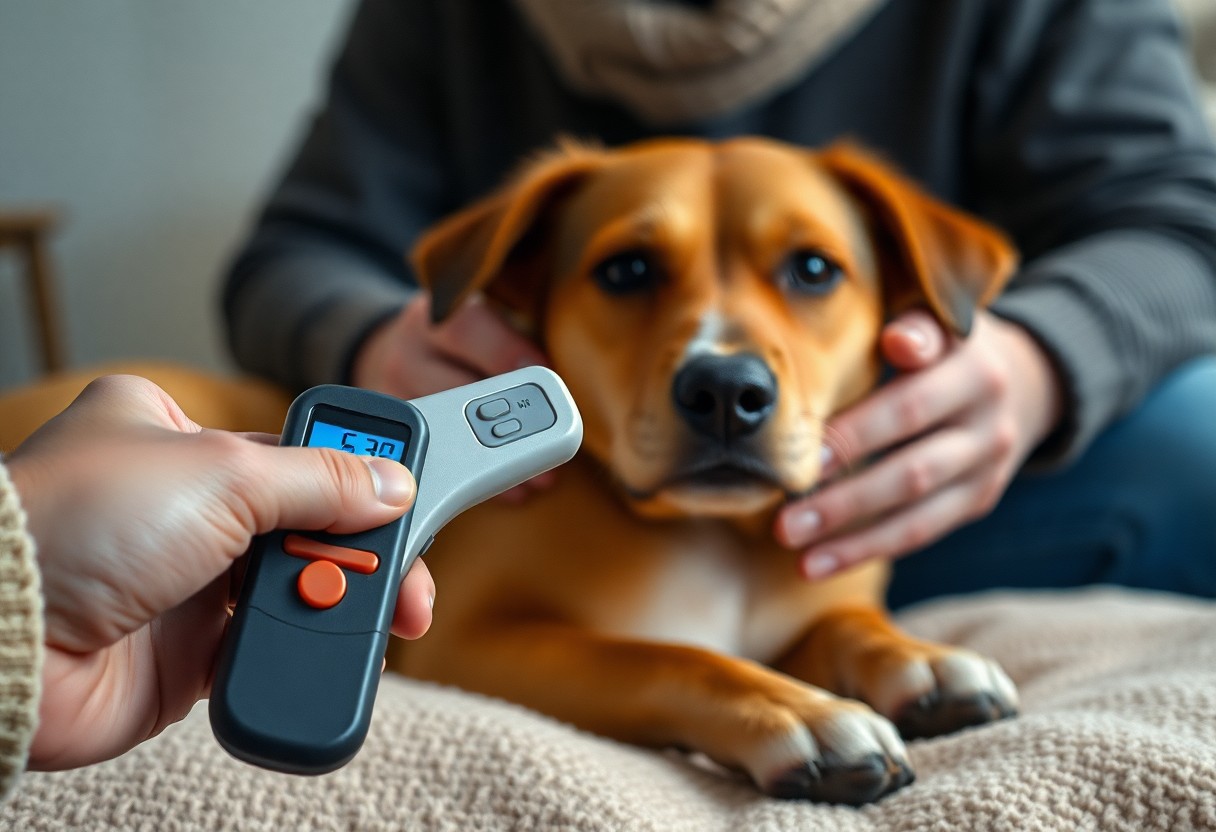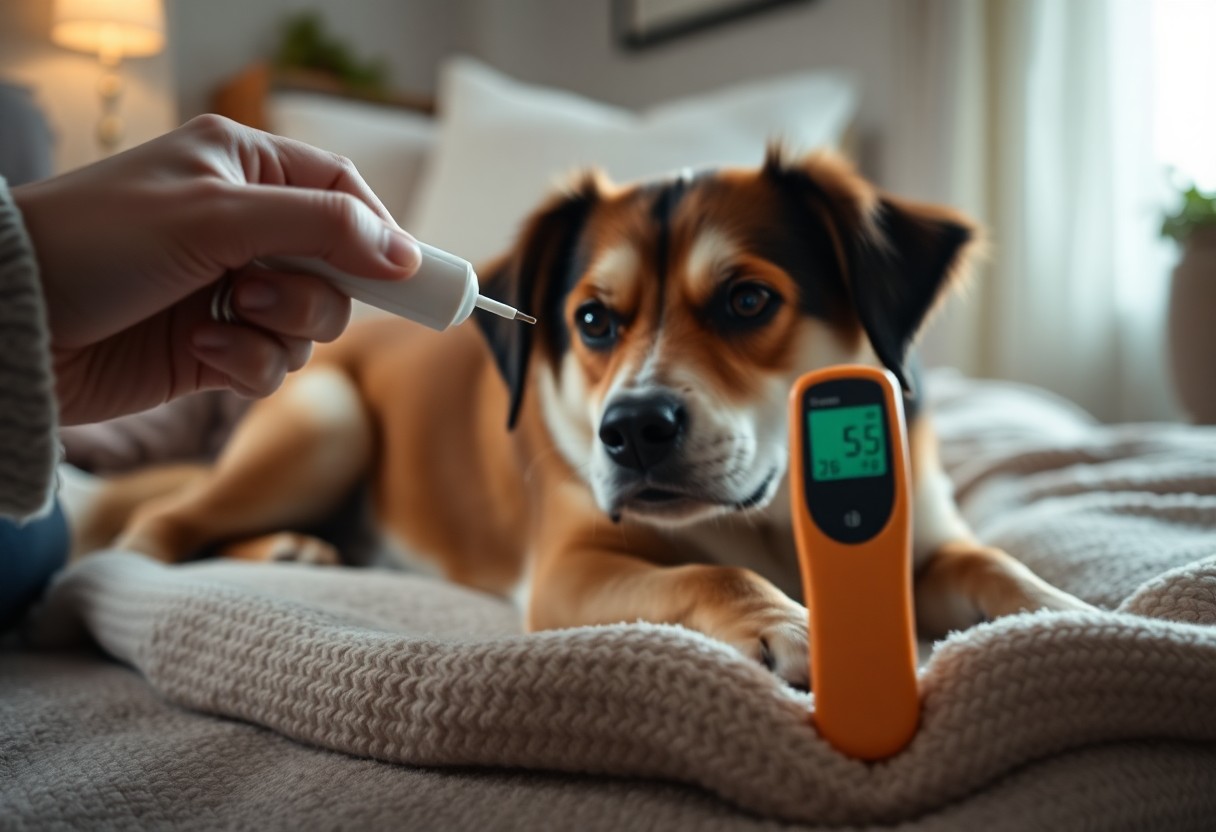There’s a good chance you might miss the subtle signs that your dog has a fever, but being attentive to changes in their behavior and physical condition is important. You may notice symptoms such as lethargy, shivering, or a warm nose, which can indicate elevated body temperature. To better understand the causes and symptoms, you can refer to Fever in Dogs: Causes, Symptoms & Care. By knowing what to look for, you can act promptly to ensure your dog’s health and comfort.
Key Takeaways:
- A dog with a fever may exhibit signs such as lethargy, shivering, loss of appetite, and warm or dry nose.
- The most accurate way to confirm a fever is by taking the dog’s temperature rectally with a thermometer; a normal dog temperature ranges between 101°F and 102.5°F.
- If a fever is confirmed or symptoms persist, it is important to consult a veterinarian to determine the cause and appropriate treatment.
Recognizing Behavioral Changes in Your Dog
Pay close attention to shifts in your dog’s behavior, as these can signal that something isn’t right. When a fever sets in, dogs often display subtle changes such as reduced interest in toys or eating, increased restlessness, or seeking more attention than usual. Noticing these variations early can guide you to check their temperature promptly and consult your vet if needed.
Signs of Discomfort or Pain
Your dog might whine, whimper, or exhibit restlessness if they’re uncomfortable due to a fever. Watch for unusual panting, shivering, or frequent shifting positions while lying down. Sometimes, dogs may lick or chew particular areas more often, indicating localized pain or general unease associated with a fever.
Altered Energy Levels and Activity
Sudden lethargy or a notable drop in activity can be a sign your dog has a fever. They might refuse walks or naps more than usual and prefer to remain in a quiet, secluded spot. This decrease in energy is the body’s way of conserving strength to fight off the infection causing the fever.
Energy level shifts can also manifest as unusual irritability or reluctance to engage, contrasting with their typical playful behavior. In some cases, dogs may appear listless or unresponsive, exhibiting reduced responsiveness to familiar stimuli like their name or favorite games, highlighting the need to monitor their condition closely.
1. Check for warm, dry nose and ears.
2. Feel for unusually hot skin or body.
3. Observe lethargy and decreased appetite.
4. Look for shivering or trembling behavior.
5. Measure temperature with a pet thermometer.
6. Seek vet advice if unsure or symptoms persist.

Physical Indicators of Canine Fever
You can often detect a fever in your dog by noting specific physical signs such as lethargy, shivering, or warm ears and nose. Dogs with a fever may also exhibit excessive panting or a decreased appetite. Monitoring these indicators regularly helps you catch early signs of illness. Observing your dog’s typical behavior and noting changes ensures prompt attention. Fever raises body temperature above the normal range of 101°F to 102.5°F, so any combination of these symptoms should prompt you to measure its temperature accurately.
Measuring Temperature Effectively
An accurate way to confirm your dog’s fever is by taking its rectal temperature using a digital thermometer designed for pets. Gently insert a lubricated thermometer about one inch into the rectum and wait for the reading. Temperatures above 103°F typically indicate a fever. You can also use an ear thermometer made for animals; however, rectal readings are more reliable. Having a trusted thermometer at home allows you to quickly verify your suspicions based on observed symptoms, guiding whether veterinary care is needed swiftly.
| Method | Details |
|---|---|
| Rectal Thermometer | Most accurate; requires lubrication and gentle insertion about 1 inch into rectum; readings over 103°F confirm fever. |
| Ear Thermometer | Quick and less invasive; useful for busy owners but less reliable; should be designed for pets. |
| Non-contact Infrared Thermometer | Measures surface temperature; can’t truly detect core body temperature; better for quick screening than diagnosis. |
Other Physical Symptoms to Observe
Apart from temperature, notice if your dog shows signs like red or glassy eyes, a dry or sticky nose, coughing, vomiting, or diarrhea, as these can accompany a fever. Examining gum color can also provide clues—a pale or bluish tint might indicate circulation issues linked with illness. Behavioral changes such as restlessness or prolonged hiding warrant attention too. These symptoms, alongside physical temperature checks, give a fuller picture of your dog’s health status.

The Role of Environment in Temperature Regulation
| Environmental Factor | Impact on Your Dog’s Temperature |
|---|---|
| Ambient Temperature | High heat can elevate your dog’s body temperature, risking heat stress; cold can lower it, causing hypothermia. |
| Humidity Levels | High humidity impairs your dog’s ability to cool through panting, potentially leading to overheating. |
| Exposure Duration | Prolonged exposure to extreme temperatures increases the chance of temperature regulation issues. |
| Shelter Quality | Proper shade and ventilation help maintain a stable body temperature during weather extremes. |
How Weather Affects Your Dog’s Health
Weather swings influence your dog’s temperature control; in hot weather, the risk of fever rises as their systems struggle to dissipate heat. Cold weather slows metabolism but can cause a dangerous drop in temperature, which might mimic feverish symptoms like shivering or lethargy. You should adjust outdoor time and provide climate-appropriate protection, like cooling mats during summer or insulated coats in winter, to support your dog’s health in varying weather conditions.
Understanding Breed-Specific Vulnerabilities
Some breeds possess distinctive traits that affect their reaction to temperature changes. Brachycephalic dogs, such as Bulldogs and Pugs, often struggle with heat due to short noses limiting airflow, elevating fever risk. Similarly, smaller breeds or long-coated dogs might retain heat differently or be more susceptible to cold stress. Knowing your breed’s unique vulnerabilities allows tailored care, helping you spot abnormal temperature changes sooner.
Diving deeper, brachycephalic breeds are prone to heatstroke as their compromised respiratory systems reduce efficient panting, a key cooling mechanism. Conversely, breeds like Huskies or Malamutes have dense double coats designed for frigid climates but can overheat quickly in warmer weather. Your choice of activity level, outdoor time, and even grooming frequency can influence how these breed characteristics manifest when temperature regulation is challenged, so observing your dog’s reactions under different environmental conditions offers valuable insights into their health status.
When to Consult a Veterinarian
Not every instance of a mild temperature rise requires a vet visit, but persistent fever above 103°F lasting more than 24-48 hours or accompanied by other warning signs demands professional evaluation. If your dog shows lethargy, dehydration, or refuses to eat alongside a fever, these are signals to seek veterinary advice promptly. Diseases ranging from infections to immune disorders can crop up, and timely action helps prevent complications. Consulting your vet ensures accurate diagnosis and tailored treatment, protecting your dog’s health effectively.
Signs That Require Immediate Attention
High fever exceeding 106°F, repeated vomiting, seizures, difficulty breathing, and collapse are all emergencies that call for urgent veterinary care. If your dog’s gums turn pale or blue, or it exhibits severe weakness and unresponsiveness, head straight to the vet without delay. These symptoms can signify life-threatening conditions such as heatstroke, severe infection, or organ failure. Quick intervention increases the chances of recovery significantly.
Discussing the Symptoms with Your Vet
Clearly describing your dog’s symptoms, including the exact duration and any behavioral changes you’ve noticed, helps your vet pinpoint the fever’s cause. Mention factors like exposure to other sick animals, recent travel, or ingestion of unusual substances. Providing a timeline along with observations about appetite, thirst, elimination, and activity levels supports a more accurate diagnosis and appropriate treatment plan.
When speaking with your vet, detailed accounts of your dog’s environment and any recent changes—like new foods, medications, or exposure to ticks—can be pivotal. Providing information about prior illnesses or chronic conditions also informs the vet’s approach. Documenting the temperature readings you’ve taken and noting any home remedies attempted aids the vet in determining the fever’s source and ruling out self-limiting causes.

Home Remedies and Care Tips for Managing Fever
To help your dog cope with fever at home, you can apply cool, damp cloths to their paws and ears to assist in lowering body heat. Provide a calm, comfortable space away from drafts or excessive heat. Monitor their temperature regularly with a pet-safe thermometer and keep a close eye on any changes in behavior or symptoms. Encourage rest and restrict vigorous activity while they recover. Offering plenty of water is necessary. Any sudden worsening of symptoms or fever persisting over 48 hours should prompt immediate veterinary attention.
Safe Fever-Reducing Techniques
Cooling your dog gradually is safest by using lukewarm water on their fur, avoiding ice packs or cold baths that might induce shock. Gently wiping their paw pads and belly with a damp cloth can help. Never give human medications like acetaminophen or ibuprofen, as these are toxic to dogs. Over-the-counter pet-specific fever reducers should only be administered under veterinary guidance. You can supplement cooling with a quiet, stress-free environment to support natural recovery processes.
Hydration and Nutrition Considerations
Maintaining hydration is key since fever promotes fluid loss through panting and increased metabolism. Offer fresh water frequently and consider electrolyte solutions formulated for pets if your dog is reluctant to drink. Light meals with easily digestible proteins and carbohydrates support energy without overloading the digestive system. Avoid heavy, fatty foods during fever periods. Sometimes small, frequent feedings work better than one large meal to maintain nutritional balance and appetite.
In addition to water, you might introduce broth (without onions or garlic) to entice your dog to drink more fluids. Cats and small breeds especially benefit from moistening dry kibble to increase moisture intake. Monitoring food intake helps identify if your dog’s appetite decreases significantly, potentially signaling complications. Consulting your vet about supplements or appetite stimulants may be advisable if your dog refuses to eat for more than 24 hours. Overall, ensuring hydration and proper nutrition supports immune function and speeds recovery during fever.
Summing up
Drawing together what you’ve learned, you’ll know your dog has a fever if they show signs like lethargy, warm ears or nose, and a warm body when you check with a thermometer. If you suspect a fever, it’s important to monitor their symptoms closely and seek professional advice if needed. For detailed guidance on temperature checking and symptoms, you can visit How can I tell if my dog has a fever? | Smokey Point Vets to ensure your pet stays healthy and comfortable.
Q: What are the common signs that my dog might have a fever?
A: If your dog has a fever, you may notice symptoms such as lethargy, shivering, loss of appetite, warm ears or nose, coughing, or nasal discharge. They might also seem more irritable than usual or seek out extra warmth. Observing these behavioral changes can help you suspect a fever before confirming it.
Q: How can I accurately check if my dog has a fever at home?
A: The most reliable way to check if your dog has a fever is by measuring their body temperature with a digital rectal thermometer designed for pets. Normal dog body temperature ranges from approximately 101 to 102.5°F (38.3 to 39.2°C). A temperature above 103°F (39.4°C) is generally considered a fever. Use a lubricant for comfort and gently insert the thermometer to get an accurate reading.
Q: When should I consult a veterinarian if I suspect my dog has a fever?
A: You should seek veterinary advice if your dog’s temperature exceeds 103°F (39.4°C), if the fever lasts more than 24 hours, or if it is accompanied by other concerning symptoms like vomiting, diarrhea, difficulty breathing, or severe lethargy. Prompt professional evaluation helps identify the underlying cause and ensures your dog receives appropriate treatment.
 wagwagtail "only love can make your dog wag her tail"
wagwagtail "only love can make your dog wag her tail"
